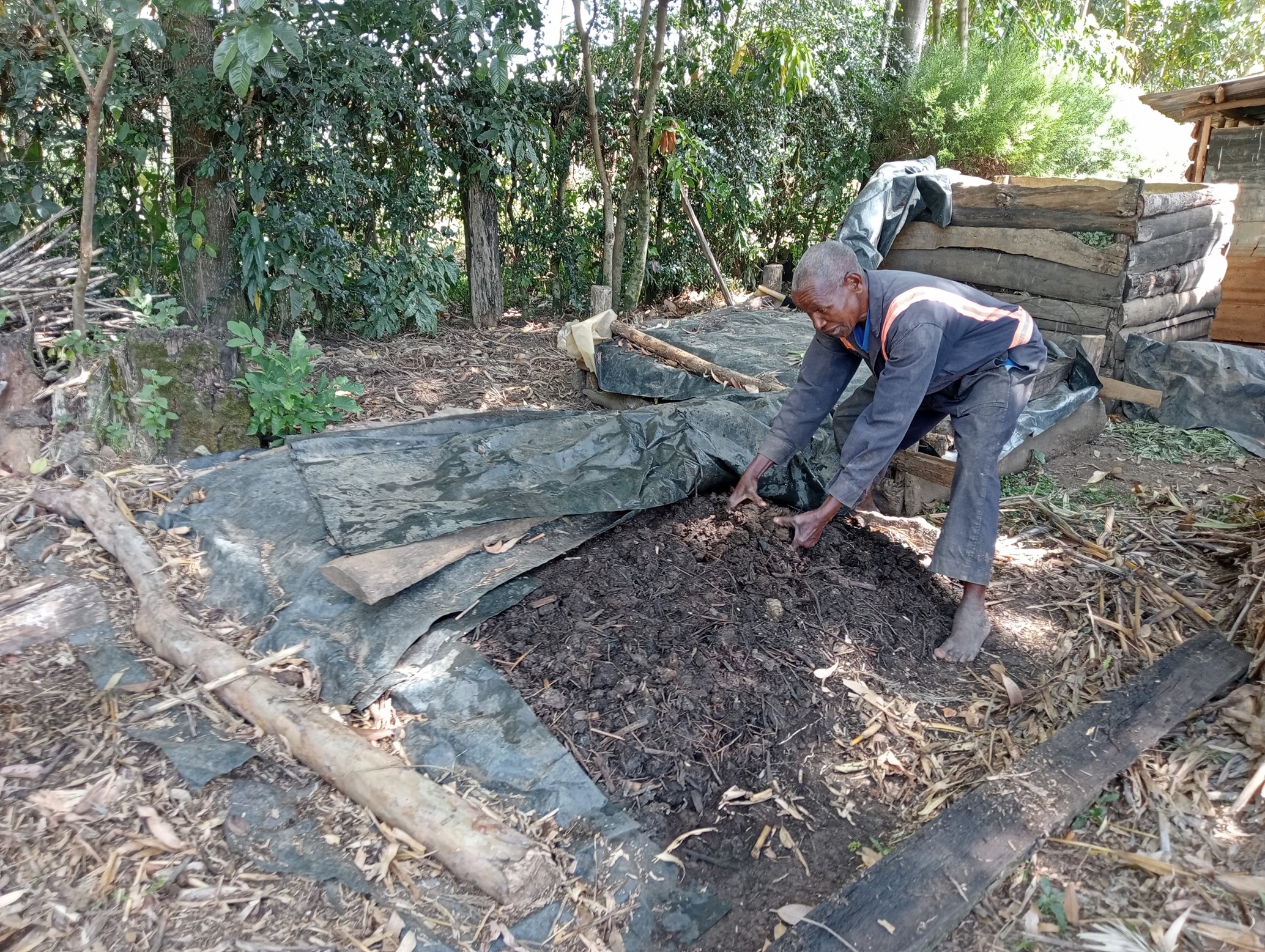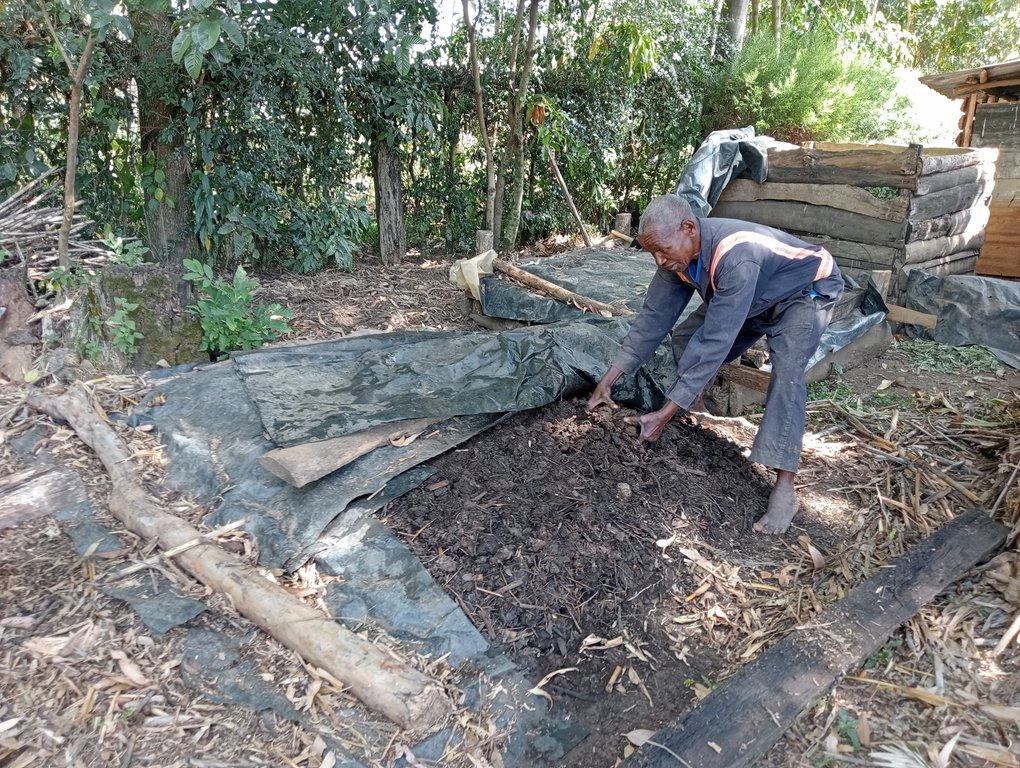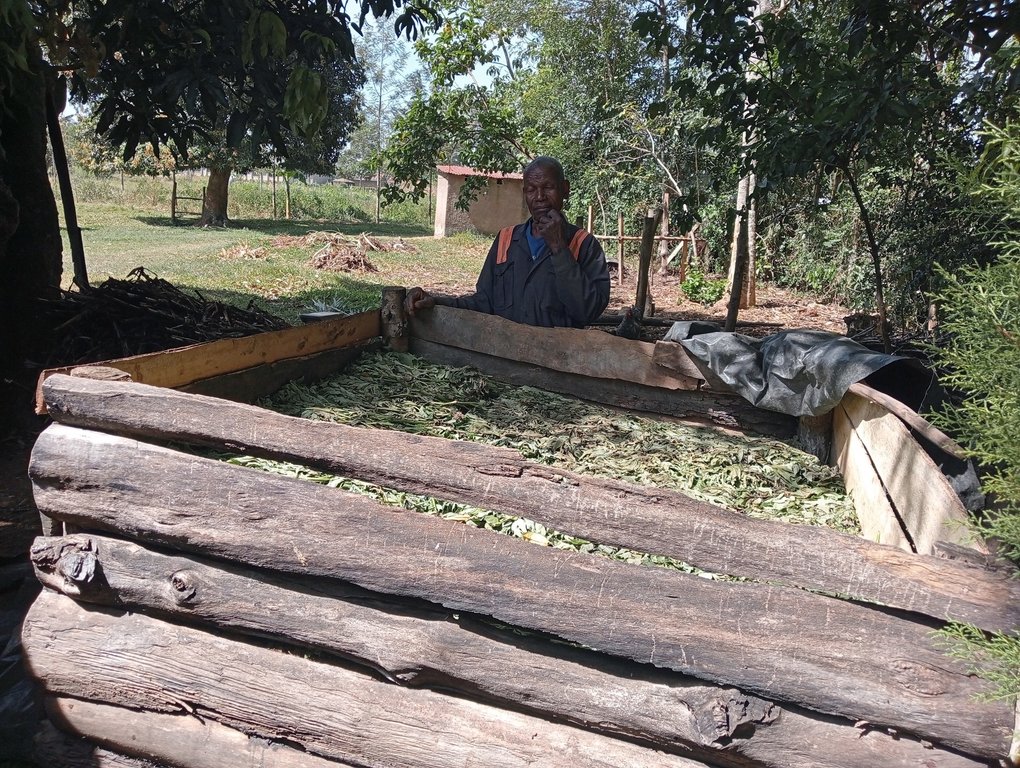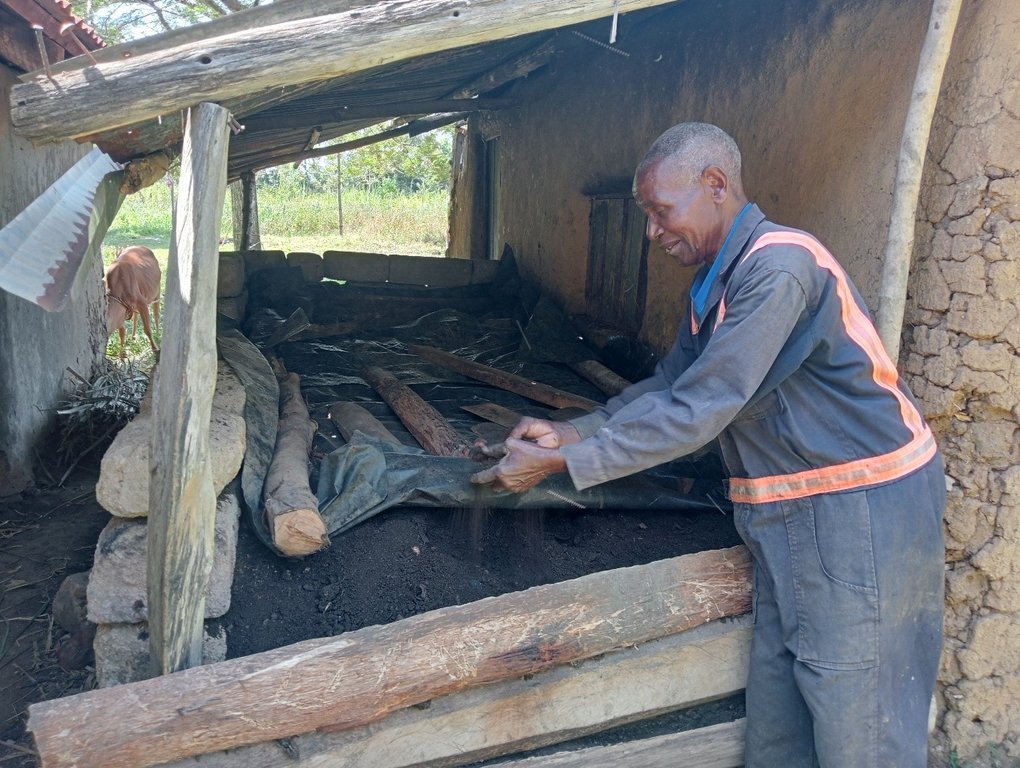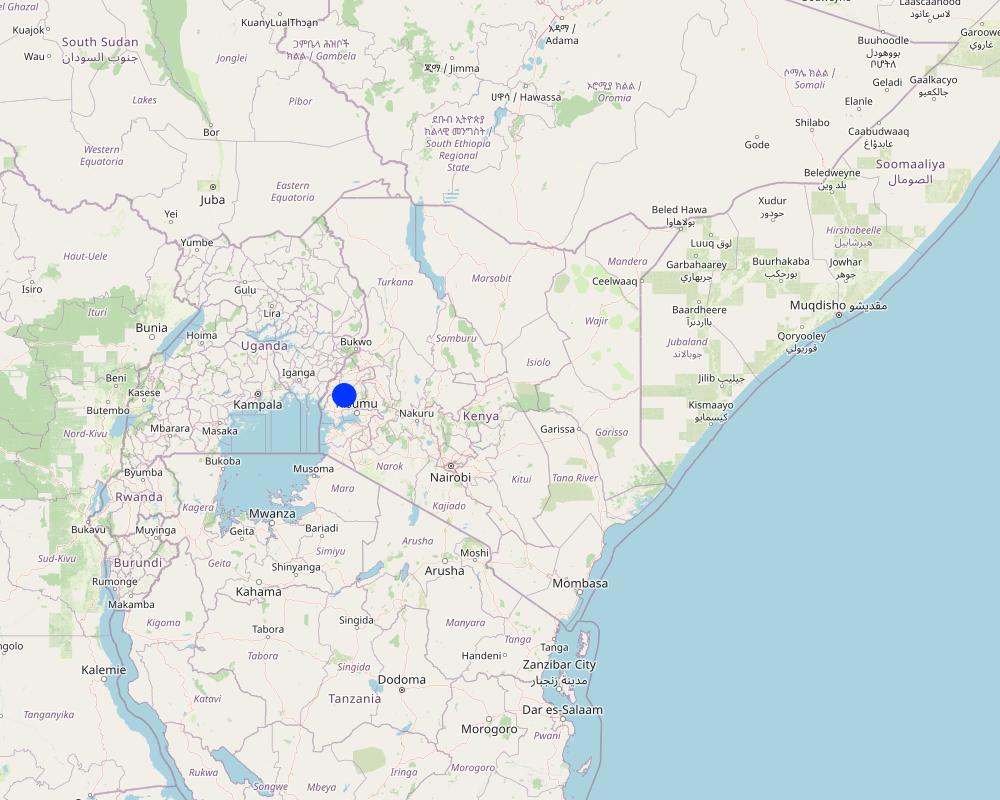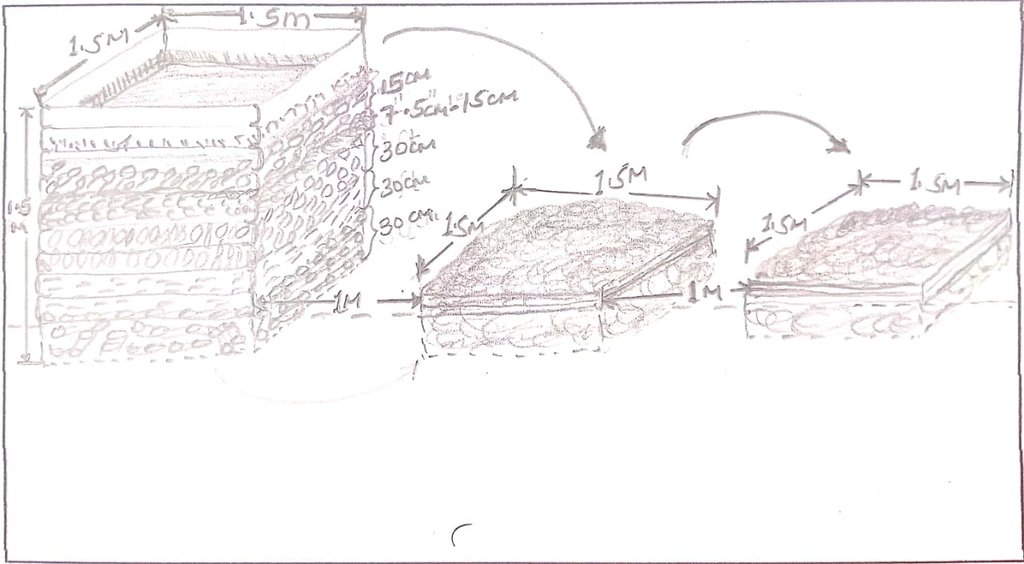Compost for organic waste management and improved crop yields [Кени]
- Шинийг нээх:
- Шинэчлэх:
- Мэдээлэл цуглуулсан: William Akwanyi
- Редакторууд: George Onyango, Innocent Faith, Noel Templer, Tabitha Nekesa, Ahmadou Gaye, Siagbé Golli
- Хянагчид: William Critchley, Rima Mekdaschi Studer, Sally Bunning
Mbolea bora (Kiswahili)
technologies_6648 - Кени
Бүлгүүдийг үзэх
Бүгдийг харуулах Бүгдийг хаах1. Ерөнхий мэдээлэл
1.2 Технологийг үнэлэх, баримтжуулах ажилд хамаарах мэдээлэл өгсөн хүмүүс, байгууллагуудын холбоо барих мэдээлэл
Мэдээлэл өгсөн хүн (с)
Газар ашиглагч :
Anyanga Matthews George
Welthungerhilfe
Кени
ГТМ мэргэжилтэн :
ГТМ мэргэжилтэн :
Технологи баримтжуулах/үнэлэх ажилд дэмжлэг үзүүлсэн төслийн нэр (шаардлагатай бол)
Soil protection and rehabilitation for food security (ProSo(i)l)Технологи баримтжуулах/үнэлэх ажилд дэмжлэг үзүүлсэн байгууллага(ууд)-ын нэр (шаардлагатай бол)
Deutsche Gesellschaft für Internationale Zusammenarbeit (GIZ)Технологи баримтжуулах/үнэлэх ажилд дэмжлэг үзүүлсэн байгууллага(ууд)-ын нэр (шаардлагатай бол)
CIAT International Center for Tropical Agriculture (CIAT International Center for Tropical Agriculture) - Кени1.3 WOCAT-аар баримтжуулсан өгөгдлийг ашиглахтай холбоотой нөхцөл
Эмхэтгэгч болон гол мэдээлэгч хүн(хүмүүс) WOCAT аргачлалаар баримтжуулсан мэдээллийг ашиглахтай холбоотой нөхцлийг хүлээн зөвшөөрсөн.
Тийм
1.4 Технологи тогтвортой гэдгийг баталгаажуулах
Энэ технологи азрын доройтлыг бууруулахад нөлөө үзүүлэхгүй тул газрын тогтвортой менежментийн технологи болж чадахгүй юу?
Үгүй
Тайлбар:
Farmers who have implemented the technology have recorded good harvests from their farms. The product of manure has improved their soils.
1.5 ГТМ Арга барилын Асуулга (ууд) руу хандах (WOCAT ашиглан баримтжуулсан)
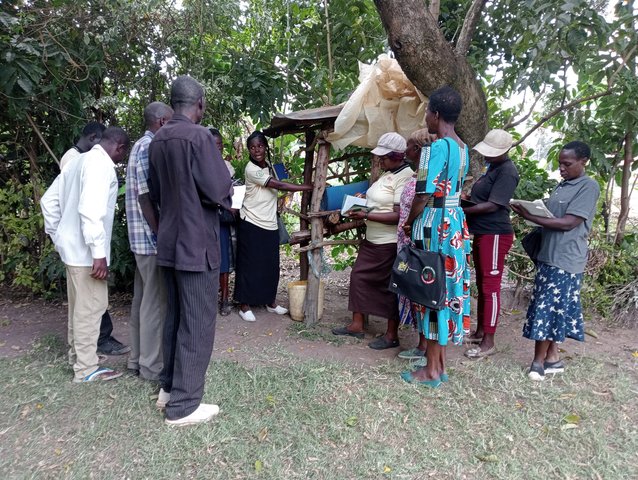
Community Resource Persons (CRP) in agricultural extension [Кени]
Community Resource Persons (CRP) form a farmer-to-farmer learning approach that bridges the gap in agricultural extension, increases farmers' access to agricultural information (SLM knowledge), and increases the adoption of SLM practices.
- Мэдээлэл цуглуулсан: William Akwanyi
2. ГТМ Технологийн тодорхойлолт
2.1 Технологийн товч тодорхойлолт
Технологийн тодорхойлолт:
Composting with on-farm organic solid waste management improves the soil sustainably and raises crop yields.
2.2 Технологийн дэлгэрэнгүй тайлбар
Тодорхойлолт:
Composting is a natural process of converting organic materials such as plant leaves, and food remains into a nutrient-rich soil-enhancing amendment called compost (if mainly from vegetative matter) or manure (if mainly from animal dung). It involves breaking organic matter down into humus/ compost by aerobic microorganisms - with by-products of water, heat, ammonia (NH3), and carbon dioxide (CO2). Humus is a dark and crumbly natural form of fertilizer applied to the soil to improve crop production. Composting is cost-effective since it can be made from locally available materials such as leaves, plant residues, food remains, cow dung, poultry droppings, animal urine, soil, etc. Composting is thus an on-farm solid waste management measure. When made correctly it can improve carbon sequestration in the soil (compost is carbon-rich) and prevent methane emissions (a greenhouse gas) since methane-producing microbes become inactive in aerobic conditions (in the presence of oxygen).
There are many ways of preparing compost. This method involves three key stages; mixing brown organic materials, such as twigs, and green materials, such as fresh leaves that are nitrogen-rich and moist. In the first stage, brown and green materials are layered, beginning with a 30 cm layer of twigs at the bottom, followed by a 30 cm layer of dry matter, such as maize straw chopped to a maximum of 7.5 cm. This is followed by a 30 cm layer of dry grass and dry leaves covered by a 7.5 cm – 15 cm layer of fresh cow dung. The fresh cow dung is covered by a 15 cm layer of fresh tithonia (an exotic plant) that is completely covered by a layer of ash and sprayed uniformly using 10 litres of animal urine and finally completely covered by a layer of soil or manure. All the above inputs except urine are sprayed with 10 – 20 litres of water. The pile is then completely covered with a black polythene sheet to help absorb heat, prevent the entry of rainwater, and prevent volatilization of nitrogen, i.e., the conversion of ammonium into ammonia gas, and left to decompose for 21 to 30 days.
The second stage involves mixing and transferring all the material except the twigs, to another space. The heap is again completely covered with a black polythene sheet to help absorb heat, prevent rainwater entry, and prevent nitrogen volatilization. It is again left to decompose for another 21 to 30 days. The third stage, like the second stage, involves completely mixing and transferring all the material from the second stage to another space and completely covering the heap with a black polythene sheet to help absorb heat and prevent the entry of rainwater. The contents are allowed to decompose for another 21 to 30 days, after which they are ready-to-use compost. The compost is stored under shade and covered with a black polythene sheet again to prevent nitrogen volatilization.
One heap of compost (first stage: 1.5 m by 1.5 m by 1.5 m) produces about 5 tonnes of ready-to-use compost. Composting takes about 90 days; hence, provided that all inputs are available, a farmer can produce compost 4 times each year from the same heaping point, i.e., about 20 tonnes. Normally, a 0.4-hectare farm requires about 20 tonnes of this compost. However, the amount varies from farm to farm depending on the conditions of the soil and the crop(s) to be grown. It is important that soil testing is done to determine the conditions of the soil to ensure that the compost is being used in the most effective manner.
Compost is carried to the farm on wheelbarrows and in buckets and is applied at the farm during planting time where a handful of compost is applied in the planting hole and mixed with soil before planting. It is again applied around the base of the crop and completely covered with soil. Preparation of compost in conservation agriculture situations could pose the problem of competition for plant material since plant material is used in conservation agriculture to cover the soil. To manage this, a farmer implementing both composting and conservation agriculture may have to acquire plant material for composting from other sources such as purchasing stover from other farmer who are not implementing conservation agriculture. In addition, the farmer could also use hedge trimmings as plant material for composting, especially if the farmer has a live fence.
2.3 Технологийн гэрэл зураг
Гэрэл зурагтай холбоотой ерөнхий тэмдэглэл:
Composting is a multi-stage process. The inputs/ materials in each stage must be completely covered with a black polythene sheet to help absorb heat, prevent the entry of rainwater, and prevent volatilization of nitrogen. The materials are allowed to decompose for at least 21 days in each stage before they are completely mixed and transferred to the next.
2.5 Энэ үнэлгээнд хамрагдсан технологийг хэрэгжүүлсэн улс орон / бүс нутаг / байршил
Улс :
Кени
Улс/аймаг/сум:
Kakamega County in western Kenya
Байршлын дэлгэрэнгүй тодорхойлолт:
Elang'ata Village, Bulanda Sub-location, Imanga Location, Marama Central Ward, Butere Sub-county
Технологи өргөн дэлгэрсэн эсхийг тодорхойл:
- тодорхой газар хэрэгжсэн/ жижиг талбайд төвлөрсөн
Технологи(иуд) нэвтрүүлсэн талбай байнгын хамгаалалттай газар нутагт байрладаг уу?
Үгүй
Тайлбар:
The farm where the technology is implemented is not in a protected area.
Map
×2.6 Хэрэгжих огноо
Хэрэгжүүлсэн он:
2018
2.7 Технологийн танилцуулга
Технологийг хэрхэн нэвтрүүлснийг тодорхойл:
- Газар ашиглагчдын санаачилгаар
- Уламжлалт системийн хэсэг (> 50 жил)
- Гадны төсөл/хөтөлбөрийн дэмжлэгтэйгээр
Тайлбар (төслийн төрөл г.м.):
For years, the farmer has been converting farm wastes into manure. However, the Soil Protection and Rehabilitation of Degraded Soil for Food Security (ProSoil) project came in and taught them an improved method of composting that takes a shorter time compared with the traditional method, and prevents loss of nutrients during composting.
3. ГТМ технологийн ангилал
3.1 Технологийн үндсэн зорилго (д)
- Үйлдвэрлэлийг сайжруулах
- Газрын доройтлыг бууруулах, сэргийлэх, нөхөн сэргээх
- Уур амьсгалын өөрчлөлт/ эрс тэс байдал болон түүний нөлөөлөлд дасан зохицох
- Уур амьсгалын өөрчлөлт, түүний үр нөлөөг багасгах
- Үр ашигтай эдийн засгийн нөлөөг бий болгох
3.2 Технологи хэвтрүүлсэн газрын одоогийн газар ашиглалтын хэлбэр(д)
Нэг газр нутгийн хэмжээнд хэрэгжих холимог газар ашиглалт:
Тийм
Газар ашиглалтын холимог тогтолцоог (тарилан/бэлчээр/ой мод) тодорхойл:
- Агро-сильво-пасторализм

Тариалангийн газар
- Нэг наст үр тариа
- Олон наст (модлог биш) тариалан
- Мод, бут тариалах
Тариалан - Таримлыг тодорхойлно уу:
- тэжээлийн ургамал - үетэн
- үр тариа - эрдэнэ шиш
- хүнсний ногоо - бусад
- буурцагт ургамал - шош
- үндсэрхэг/булцуут таримал - кассава
Тариалалтын тогтолцоо:
Эрдэнэ шиш/буурцаг/шар будааг шоштой сөөлжлөн тариалсан
Олон наст (модлог биш) тариалан - Таримлыг тодорхойлно уу:
- Банан/таван салаа/абака
Мод, бут тариалах - Таримлыг тодорхойлно уу:
- авакадо
- жимс, бусад
- манго, давжаа манго, гуав
- папайяа
Нэг жил дэх ургамал ургах улирлын тоо:
- 2
Тодорхойлно уу:
Long and short rain seasons
Сөөлжлөн тариалалт хийгддэг үү?
Тийм
Хэрэв тийм бол ямар таримлыг сөөлжлөн тариалдаг вэ?
Maize and beans
Таримлыг ээлжлэн тариалдаг уу?
Тийм
Хэрэв тийм бол, тодруулна уу:
Some sections of the farm are left fallow during the short rains to allow for soil regeneration.

Бэлчээрийн газар
Эрчимжсэн бэлчээр / тэжээл үйлдвэрлэл:
- Хадлан буюу бэлчээрт ашиглагдахгүй талбай
- Сайжруулсан бэлчээр
амьтдын төрөл зүйл:
- үхрийн аж ахуй - цагаан идээ
- үхрийн аж ахуй - сүүний ба махны чиглэлийн (жишээ нь зебу)
- тахиа
Тариалан-мал аж ахуйн нэгдсэн менежмент хэрэгждэг үү?
Тийм
Хэрэв тийм бол, тодруулна уу:
Cattle dung and poultry droppings are used as inputs in composting. Compost is applied on soil where livestock fodder is planted.
Бүтээгдэхүүн ба үйлчилгээ:
- эдийн засгийн аюулгүй байдал, хөрөнгө оруулалт татах чадвар
- сүү
- бордоо/эрчим хүчний үйлдвэрлэлд ашиглах бууц
- өндөг
- мах
Төрөл зүйл:
үхрийн аж ахуй - цагаан идээ
Тоо хэмжээ:
2
Төрөл зүйл:
үхрийн аж ахуй - сүүний ба махны чиглэлийн (жишээ нь зебу)
Тоо хэмжээ:
3
Төрөл зүйл:
тахиа
Тоо хэмжээ:
10
Тайлбар:
There are assorted trees on the farm, and these provide litter which is an input in composting.
3.3 Технологи хэрэгжүүлснээс газар ашиглалтад өөрчлөлт гарсан уу?
Технологи хэрэгжүүлснээс газар ашиглалтад өөрчлөлт гарсан уу?
- Үгүй (3.4 хариулт руу шилжинэ үү)
3.4 Усан хангамж
Технологи хэрэгжүүлсэн газрын усан хангамж:
- Байгалийн усалгаатай
Тайлбар:
Crops are planted only during the rainy seasons since there is no irrigation.
3.5 Технологи ГТМ-ийн аль бүлэгт хамаарах
- Газар тариалан-мал аж ахуйн нэгдсэн менежмент
- Хөрсний үржил шимт цогц менежмент
- Хог хаягдлын менежмент / хаягдал усны менежмент
3.6 Технологийг бүрдүүлэх ГТМ арга хэмжээ

Агрономийн арга хэмжээ
- А2: Органик нэгдэл/ хөрсний үржил шим
- А6: Хагд өвсний менежмент
А6: Хагд өвсний менежментийг тодорхойлно уу:
А 6.3: цуглуулах
Тайлбар:
Plant residues, especially leaves and soft branches are collected and used as input in composting. However, some plant matter is retained in the farm to naturally decompose and turn into manure at the farm. The farmer does not collect plant residues from protected areas. He has planted tithonia at some sections of the hedges at his farm; this provides the main source of tithonia. However, he sometimes harvests tithonia from his neighbours' hedges upon request.
3.7 Технологийн шийдвэрлэсэн газрын доройтлын үндсэн төрлүүд

Хөрсний химийн доройтол
- Cn: Үржил шим болон органик агууламж буурах (элэгдлийн шалтгаангүй)
- Ca: Хүчилжилт
- Cp: Хөрсний бохирдол
Тайлбар:
Covering of compost-making materials and the final compost reduces loss of nitrogen through volatilization of ammonium into ammonia gas. Compost raises the pH of soils when applied at the farm. Compost contains living organisms (bacteria and fungi) that degrade soil pollutants into non-toxic substances.
3.8 Газрын доройтлоос урьдчилан сэргийлэх, сааруулах ба нөхөн сэргээх
Газрын доройтолтой холбоотойгоор Технологи ямар зорилго тавьсан болохыг тодорхойл:
- Газрын доройтлоос урьдчилан сэргийлэх
- Хүчтэй доройтсон газрыг нөхөн сэргээх/ сайжруулах
Тайлбар:
Compost improves soil structure and porosity. Compost balances soil pH.
4. Техникийн нөхцөл, хэрэгжилтийн үйл ажиллагаа, материал ба зардал
4.1 Технологийн техникийн зураг
Техник тодорхойлолт (техник зурагтай уялдана):
Stage 1: about 30 cm deep under the ground, 1.5 m long by 1.5 m wide by 1.5 m high, including the 30 cm below the ground. Constructed using timber off-cuts (locally known as magogo) supported on posts at corners using nails. From bottom: 30 cm of twigs to extend some few inches above the ground to allow air circulation, 30 cm of dry matter e.g., maize straw chopped to 7.5 cm maximum, 30 cm dry grass and leaves, 7.5 cm - 15 cm layer of fresh cow dung, 15 cm layer of fresh tithonia, layer of ash, layer of soil or manure, black polythene sheet cover.
Stages 2 and 3: about 1-ft deep under the ground, 1.5 m long by 1.5 m wide, height depends on the volume of the material.
Allow space of no more than 1 m from one stage to the other for easy of mixing and transfer of materials from one stage to the next.
Зохиогч:
William Onura
Он, сар, өдөр:
26/01/2023
4.2 Материал болон зардалд хамаарах ерөнхий мэдээлэл
Үнэ өртөг, оруулсан хувь нэмрийг хэрхэн тооцсоныг тодорхойл:
- Технологийн нэгж тус бүр
Нэгжийг тодорхойл:
Heap of compost
Нэгж хэмжигдэхүүний хэмжих нэгжийн тодорхойлох (шаардлагатай бол):
1.5 m by 1.5 m by 1.5 m
бусад/үндэсний мөнгөн нэгж (тодорхойл):
KES
Хэрэв боломжтой бол үндэсний валютын Америк доллартай харьцах харьцааг бичнэ үү (тухайлбал, 1 ам.дол. = 79,9 Бразил реал): 1 ам.дол. =:
122.95
Хөлсний ажилчны нэг өрдийн ажлын хөлсийг тодорхойл:
200
4.3 Байгуулах үйл ажиллагаа
| Үйл ажиллагаа | Хугацаа (улирал) | |
|---|---|---|
| 1. | Digging of pits | At least 3 months before planting time |
| 2. | Framework construction with off cuts | At least 3 months before planting time |
| 3. | Filling stage one with inputs | At least 3 months before planting time |
Тайлбар:
Composting takes about 3 months; hence, the farmer should have the structures for composting at least 3 months before the planting time. A farmer can produce 20 tonnes of compost from 1 heap (1.5 m by 1.5 m by 1.5 m).
4.4 Байгуулалтад шаардагдах зардал ба материал
| Хөрөнгө оруулалтыг дурьдана уу | Хэмжих нэгж | Тоо хэмжээ | Нэгжийн өртөг | Материал бүрийн нийт өртөг | % газар ашиглачаас гарсан зардал | |
|---|---|---|---|---|---|---|
| Хөдөлмөр эрхлэлт | Framework construction | Man-days | 2.0 | 200.0 | 400.0 | 100.0 |
| Хөдөлмөр эрхлэлт | Filling inputs | Man-days | 1.0 | 200.0 | 200.0 | 100.0 |
| Тоног төхөөрөмж | Jembe (hoe) | No. | 1.0 | 80.0 | 80.0 | |
| Тоног төхөөрөмж | Spade | No. | 1.0 | 90.0 | 90.0 | |
| Тоног төхөөрөмж | Fork hoe | No. | 1.0 | 70.0 | 70.0 | |
| Тоног төхөөрөмж | Wheelbarrow | No. | 1.0 | 800.0 | 800.0 | |
| Тоног төхөөрөмж | Hummer | No. | 1.0 | 100.0 | 100.0 | 100.0 |
| Тоног төхөөрөмж | Handsaw | No. | 1.0 | 200.0 | 200.0 | 100.0 |
| Таримал материал | Twigs | Wheelbarrow | 2.0 | 100.0 | 200.0 | 100.0 |
| Таримал материал | Dry matter | Wheelbarrow | 6.0 | 50.0 | 300.0 | 100.0 |
| Таримал материал | Dry grass and leaves | 90 Kg sack | 3.0 | 50.0 | 150.0 | 100.0 |
| Таримал материал | Fresh tithonia | 90 Kg sack | 3.0 | 50.0 | 150.0 | 100.0 |
| Бордоо ба биоцид | Ash | 90 Kg sack | 0.4 | 200.0 | 80.0 | 100.0 |
| Бордоо ба биоцид | Animal urine | 10 litre container | 1.0 | 125.0 | 125.0 | 100.0 |
| Бордоо ба биоцид | Soil or manure | Wheelbarrow | 1.0 | 300.0 | 300.0 | 100.0 |
| Бордоо ба биоцид | Fresh cow dung | Wheelbarrow | 3.0 | 200.0 | 600.0 | 100.0 |
| Барилгын материал | Timber off-cuts | Pieces | 16.0 | 100.0 | 1600.0 | 100.0 |
| Барилгын материал | Wooden posts | Pieces | 4.0 | 50.0 | 200.0 | 100.0 |
| Барилгын материал | Nails (assorted sizes) | Kgs | 3.0 | 200.0 | 600.0 | 100.0 |
| Бусад | Water | 20 litres container | 4.0 | 5.0 | 20.0 | 100.0 |
| Технологи бий болгох нийт үнэ өртөг | 6265.0 | |||||
| Технологи бий болгох нийт үнэ өртөг, ам.доллар | 50.96 | |||||
Хэрэв газар ашиглагчаас нийт өртөгийн 100%хүрэхгүй зардал гарсан бол хэн үлдсэн хөрөнгө оруулалтыг хийснийг тодорхойл.
ProSoil project
Тайлбар:
The ProSoil project through Welthungerhilfe provided hoes, fork hoes, wheelbarrows, and spades to the farmers. The costs of these implements are KES 400/- for a hoe, KES 350/- for a fork hoe, KES 4,000/- for a wheelbarrow, KES 450/- for a spade, KES 500/- for a hummer, and KES 1,000/- for a handsaw. It is assumed that the farmer will be able to use the hoe, fork hoe, spade, hummer, and handsaw over a period of 5 years, and a wheelbarrow over a period of 10 years before these implements will have depreciated to a point where they will not be useable. The cost is thus spread over the years when the farmer will be able to use the implement.
4.5 Засвар үйлчилгээ / давтагдах үйл ажиллагаа
| Үйл ажиллагаа | Хугацаа/ давтамж | |
|---|---|---|
| 1. | Turning at each stage | 21 - 30 days after start of each stage |
| 2. | Refilling at the first stage | At turning from the first stage |
| 3. | Distribution to the farm | When planting and at first weeding (i.e., 3rd week after planting) |
Тайлбар:
Turning involves complete mixing and transfer of the inputs from one stage to the next. Compost is applied at the farm during planting time where a handful of compost is applied in the planting hole and mixed with soil before planting. It is again applied around the base of the crop and completely covered with soil.
4.6 Засвар үйлчилгээ / урсгал үйл ажиллагаанд шаардагдах зардал ба материал (жилээр)
| Хөрөнгө оруулалтыг дурьдана уу | Хэмжих нэгж | Тоо хэмжээ | Нэгжийн өртөг | Материал бүрийн нийт өртөг | % газар ашиглачаас гарсан зардал | |
|---|---|---|---|---|---|---|
| Хөдөлмөр эрхлэлт | Complete mixing and turning from stage one to stage two and from stage two to stage three | Man-days | 4.0 | 200.0 | 800.0 | 100.0 |
| Хөдөлмөр эрхлэлт | Refilling with new materials at the first stage | Man-days | 1.0 | 200.0 | 200.0 | 100.0 |
| Хөдөлмөр эрхлэлт | Transfer to storage | Man-days | 2.0 | 200.0 | 400.0 | 100.0 |
| Хөдөлмөр эрхлэлт | Distribution to the farm | Man-days | 2.0 | 200.0 | 400.0 | 100.0 |
| Тоног төхөөрөмж | Hoe | No. | 1.0 | 80.0 | 80.0 | |
| Тоног төхөөрөмж | Fork hoe | No. | 1.0 | 90.0 | 90.0 | |
| Тоног төхөөрөмж | Spade | No. | 1.0 | 70.0 | 70.0 | |
| Тоног төхөөрөмж | Wheelbarrow | No. | 1.0 | 400.0 | 400.0 | |
| Таримал материал | Dry matter | Wheelbarrow | 6.0 | 50.0 | 300.0 | 100.0 |
| Таримал материал | Dry grass and leaves | 90Kg sack | 3.0 | 50.0 | 150.0 | 100.0 |
| Таримал материал | Fresh tithonia | 90Kg sack | 3.0 | 50.0 | 150.0 | 100.0 |
| Бордоо ба биоцид | Ash | 90 Kg sack | 0.4 | 200.0 | 80.0 | 100.0 |
| Бордоо ба биоцид | Animal urine | 10 litre container | 1.0 | 125.0 | 125.0 | 100.0 |
| Бордоо ба биоцид | Soil or manure | Wheelbarrow | 1.0 | 300.0 | 300.0 | 100.0 |
| Бордоо ба биоцид | Fresh cowdung | Wheelbarrow | 3.0 | 200.0 | 600.0 | 100.0 |
| Бусад | Water | 20 litres container | 4.0 | 5.0 | 20.0 | 100.0 |
| Технологийг арчилах тордоход шаардагдах нийт үнэ өртөг | 4165.0 | |||||
| Технологи сайжруулах нийт үнэ өртөг, ам.доллар | 33.88 | |||||
Хэрэв газар ашиглагчаас нийт өртөгийн 100%хүрэхгүй зардал гарсан бол хэн үлдсэн хөрөнгө оруулалтыг хийснийг тодорхойл.
ProSoil project
Тайлбар:
The hoes, fork hoes, wheelbarrows, and spades provided by the ProSoil project through Welthungerhilfe are fixed assets and are used for years by the farmer before they can wear out. The farmer can use these implements for other work at the farm. The costs of these implements are KES 400/- for a hoe, KES 350/- for a fork hoe, KES 4,000/- for a wheelbarrow, and KES 450/- for a spade. It is assumed that the farmer will be able to use the hoe, fork hoe, and spade over a period of 5 years, and a wheelbarrow over a period of 10 years before these implements will have depreciated to a point where they will not be useable. The cost is thus spread over the years when the farmer will be able to use the implement. The twigs are reused during the refilling process since they take long to decompose.
4.7 Зардалд нөлөөлж байгаа хамгийн чухал хүчин зүйл
Өртөг зардлыг тодорхойлох гол хүчин зүйлсийг дурьдана уу:
Rate of man-days vary from one place to another. It is not easy to attach monetary value to some of the input e.g., animal urine, cow dung, and water.
Exchange rate for January 2023, source: European Commission/ InfoEuro online at https://commission.europa.eu/funding-tenders/procedures-guidelines-tenders/information-contractors-and-beneficiaries/exchange-rate-inforeuro_en
5. Хүн, байгалийн хүрээлэн буй орчин
5.1 Уур амьсгал
Жилийн нийлбэр хур тундас
- <250 мм
- 251-500 мм
- 501-750 мм
- 751-1,000 мм
- 1,001-1,500 мм
- 1,501-2,000 мм
- 2,001-3,000 мм
- 3,001-4,000 мм
- > 4,000 мм
Хур тунадасны талаархи тодорхойлолт/ тайлбар:
Monthly rainfall variability is high with some months such as January recording less than 5 mm of total rainfall.
Суурь болгон авсан цаг уурын станцын нэр:
Kakamega Meteorological Station
Агро-уур амьсгалын бүс
- Чийглэг
The climate in the area favours most agricultural activities.
5.2 Байрзүйн зураг
Дундаж налуу:
- Тэгш (0-2 %)
- Бага зэрэг хэвгий (3-5 %)
- Дунд зэрэг хэвгий (6-10 % )
- Долгиорхог (11-15 %)
- Толгодорхог (16-30 %)
- Эгц налуу (31-60 % )
- Огцом эгц налуу (>60 %)
Гадаргын хэлбэр:
- Тэгш өндөрлөг/тэгш тал
- Зоо, хяр
- Уулын энгэр, хажуу
- Ухаа, гүвээ, дов толгод
- Уулын бэл
- Хөндий, хоолой, нам хотос
Өндөршлийн бүс:
- 0-100 м д.т.д
- 101-500 м д.т.д
- 501-1,000 м д.т.д
- 1,001-1,500 м д.т.д
- 1,501-2,000 м д.т.д
- 2,001-2,500 м д.т.д
- 2,501-3,000 м д.т.д
- 3,001-4,000 м д.т.д
- > 4,000 м д.т.д
Технологи дараах асуудалд хандсан эсэхийг тодорхойл:
- шаардлагагүй
Гадаргын талаархи тайлбар ба бусад тодорхойлолт:
The farm is located at an area that is higher in altitude compared to other areas in the larger area. The average altitude for the area is 1,350m above sea level but the farm is at 1,401m above sea level.
5.3 Хөрс
Хөрсний дундаж зузаан:
- Маш нимгэн (0-20 см)
- Нимгэн (21-50 см)
- Дунд зэрэг зузаан (51-80 см)
- Зузаан (81-120 cм)
- Маш зузаан (>120 cм)
Хөрсний бүтэц (өнгөн хөрс):
- Дунд зэрэг (шавранцар)
Хөрсний бүтэц (>20 см-ээс доош):
- Сийрэг/хөнгөн (элсэрхэг)
Өнгөн хөрсний органик нэгдэл:
- Дунд (1-3 % )
Боломжтой бол хөрсний бүрэн тодорхойлолт, боломжит мэдээллийг өгнө үү, жишээ нь хөрсний төрөл, хөрсний урвалын орчин/хүчиллэг байдал, катион солилцох чадавхи, азотын хэмжээ, давсжилт г.м.
Soil pH of most farms in the area ranges from moderately acid (5.50) to moderately alkaline (7.80).
5.4 Усны хүртээм ба чанар
Хөрсний усны гүн:
5-50 м
Гадаргын усны хүртээмж:
Сайн
Усны чанар (цэвэрлээгүй):
Муу чанарын ундны ус (цэвэршүүлэх шаардлагатай)
Усны чанар гэж:
гадаргын болон ул хөрсний ус
Усны давсжилт асуудал болдог уу?
Үгүй
Энэ газар үер усанд автдаг уу?
Үгүй
Усны чанар, нөөцийн талаархи тайлбар ба бусад тодорхойлолт:
There are several boreholes in the area and according to interviews with some borehole owners, the depts are not more than 50 metres.
5.5 Биологийн төрөл зүйл
Зүйлийн олон янз байдал:
- Дунд зэрэг
Амьдрах орчны олон янз байдал:
- Дунд зэрэг
Биологийн олон янз байдлын талаархи тайлбар ба бусад тодорхойлолт:
The area has high agrobiodiversity since most farms are under crops and trees.
5.6 Технологи нэвтрүүлсэн газар ашиглагчидын онцлог шинж
Суурьшмал эсвэл нүүдлийн:
- Хагас-нүүдэлчин
Үйлдвэрлэлийн системийн зах зээлийн чиг баримжаа:
- холимог (амьжиргаа ба худалдаанд)
Фермээс гадуурх орлого:
- Нийт орлогын %50 дээш хувь
Чинээлэг байдлыг харьцангуй түвшин:
- Дундаж
Хувь хүн эсвэл бүлэг:
- Хувь хүн / өрх
Механикжилтын түвшин:
- Хүнд хүчир ажил
- Амьтны зүтгүүр
Хүйс:
- Эмэгтэй
- Эрэгтэй
Газар ашиглагчийн нас:
- Залуус
- Дунд нас
- Ахимаг нас
Газар ашиглагчдын бусад шаардлагатай шинж чанарыг тодорхойл:
The farmer uses the land together with his other family members.
5.7 Технологи нэвтрүүлэхэд газар ашиглагчийн ашигласан газрын дундаж талбай
- < 0.5 га
- 0.5-1 га
- 1-2 га
- 2-5 га
- 5-15 га
- 15-50 га
- 50-100 га
- 100-500 га
- 500-1,000 га
- 1,000-10,000 га
- > 10,000 га
Энэ нь жижиг, дунд, том оворт тооцогдох уу (орон нутгийн чиг баримжаагаар)?
- Дунд-хэмжээний
Тайлбар:
Farmers with more than 2 ha in the area are considered to have large pieces of land since there is high level of land fragmentation in the area.
5.8 Газар эзэмшил, газар ашиглах эрх, ус ашиглах эрх
Газар өмчлөл:
- Хувь хүн, тодорхой цол эргэмгүй
- Хувь хүн, цол эргэм бүхий
Газар ашиглах эрх:
- Түрээсийн хэлбэрээр
- Хувь хүн
Ус ашиглах эрх:
- Нээлттэй хүртэх (зохион байгуулалтгүй)
- Хувь хүн
Газар ашиглалтын эрх уламжлалт эрхзүйн тогтолцоонд суурилдаг уу?
Үгүй
Тодорхойлно уу:
Each landowner has full control of the way he/ she wants to use his/ her land.
Тайлбар:
The farmer has an official ownership title for his piece of land. He also leases other people's pieces of land for farming. Water in the streams and springs is freely accessed without restrictions. There is a borehole in the neighbourhood, and the managers of this borehole have set rules for accessing the water thereat.
5.9 Дэд бүтэц, үйлчилгээний хүртээмж
эрүүл мэнд:
- Ядуу
- Дунд зэргийн
- Сайн
боловсрол:
- Ядуу
- Дунд зэргийн
- Сайн
техник дэмжлэг:
- Ядуу
- Дунд зэргийн
- Сайн
хөдөлмөр эрхлэлт (жишээ нь, ХАА-аас өөр):
- Ядуу
- Дунд зэргийн
- Сайн
зах зээл:
- Ядуу
- Дунд зэргийн
- Сайн
эрчим хүч:
- Ядуу
- Дунд зэргийн
- Сайн
зам ба тээвэр:
- Ядуу
- Дунд зэргийн
- Сайн
ундны ус ба ариутгал:
- Ядуу
- Дунд зэргийн
- Сайн
санхүүгийн үйлчилгээ:
- Ядуу
- Дунд зэргийн
- Сайн
Тайлбар:
The above rating varies from one village to the other.
6. Үр нөлөө ба дүгнэлт
6.1 Технологийн талбай дахь үр нөлөө
Нийгэм-эдийн засгийн үр нөлөө
Үйлдвэрлэл
Газар тариалангийн үйлдвэрлэл
ГТМ хэрэгжхээс өмнөх тоо хэмжээ:
Less than 4
ГТМ хэрэгжсэнээс хойшхи тоо хэмжээ:
More than 8
Тайлбар/ тодорхой дурьдах:
Quantity refers to the number of 90 Kg bags of maize produced per acre. Based on measurement by the farmer.
үр тарианы чанар
Тайлбар/ тодорхой дурьдах:
Not easy to quantify. The crops do better compared to how they could do in the past, yet he does not use inorganic fertilizers. Based on estimation by the farmer.
тэжээл үйлдвэрлэл
ГТМ хэрэгжхээс өмнөх тоо хэмжээ:
2
ГТМ хэрэгжсэнээс хойшхи тоо хэмжээ:
3 - 4
Тайлбар/ тодорхой дурьдах:
Quantity refers to harvesting cycles for nappier grass from the same farm. He applies compost on the pieces of land where he has grown fodder. The fodder does better than how it used to do before when he was not applying compost.
тэжээлийн чанар
Тайлбар/ тодорхой дурьдах:
He applies compost on the pieces of land where he has grown fodder.
малын бүтээмж
ГТМ хэрэгжхээс өмнөх тоо хэмжээ:
1 - 3
ГТМ хэрэгжсэнээс хойшхи тоо хэмжээ:
3 - 10
Тайлбар/ тодорхой дурьдах:
Quantity refers to the amount of milk in litres from one cow. He gets more milk from his cows as compared to what he used to get before the SLM since applying compost on the pieces of land where he has grown fodder makes the fodder to grow faster. Milk production is often at the peak during early lactation months.
үйлдвэрлэл зогсох эрсдэл
ГТМ хэрэгжхээс өмнөх тоо хэмжээ:
Over 50
ГТМ хэрэгжсэнээс хойшхи тоо хэмжээ:
Less than 10
Тайлбар/ тодорхой дурьдах:
Quantity refers to the percentage probability of the crop failing to do well. Quote from the farmer, '... it was 50 50 getting any produce before I started using compost ...' meaning that there was high chance that the crop could fail due to poor soils. Compost is a rich source of organic matter; hence, ensure sustainable agricultural production.
Орлого, зарлага
ХАА-н хөрөнгө оруулалтын зардал
ГТМ хэрэгжхээс өмнөх тоо хэмжээ:
Over 5,000
ГТМ хэрэгжсэнээс хойшхи тоо хэмжээ:
0
Тайлбар/ тодорхой дурьдах:
Quantity refers to the amount of money in Kenya shillings spend on inorganic fertilizers in a season. The farmers no longer spend money inorganic fertilizers.
тариалангийн газрын орлого
ГТМ хэрэгжхээс өмнөх тоо хэмжээ:
Less than 2,000
ГТМ хэрэгжсэнээс хойшхи тоо хэмжээ:
20,000
Тайлбар/ тодорхой дурьдах:
Quantity refers to the amount of money in Kenya shillings received from the sale of farm produce, including compost in a year. The farmer is able to sell surplus crop and animal products as a result of bumper harvest due to the use of compost on his farm.
орлогын олон янз эх үүсвэр
ГТМ хэрэгжхээс өмнөх тоо хэмжээ:
1 - 3
ГТМ хэрэгжсэнээс хойшхи тоо хэмжээ:
More than 3
Тайлбар/ тодорхой дурьдах:
Quantity refers to household income sources, including sale of surplus farm produce and compost. The farmer is able to sell surplus crop and animal products, and other on-farm products such and compost.
хөдөлмөр хүчний хэмжээ
ГТМ хэрэгжхээс өмнөх тоо хэмжээ:
Over 5
ГТМ хэрэгжсэнээс хойшхи тоо хэмжээ:
Less than 1
Тайлбар/ тодорхой дурьдах:
Quantity refers to the number of hours that the farmer can be free in any working day. A lot of work is involved in the preparation and maintenance of compost in order to achieve the desired results.
Нийгэм-соёлын үр нөлөө
хүнсний аюулгүй байдал/ өөрийгөө хангах
ГТМ хэрэгжхээс өмнөх тоо хэмжээ:
About 3 months of purchasing maize
ГТМ хэрэгжсэнээс хойшхи тоо хэмжээ:
No months when there is total lack of food in the house
Тайлбар/ тодорхой дурьдах:
Quantity refers to the number of months in a year when there is total lack of food in the house, and the farmer has to buy all the food required in the house. The soils at the farm have been enhanced; hence, the farmer grows a variety of crops. Food is available in the household to sustain the family from one harvest to the next.
ГТМ/ газрын доройтлын талаархи мэдлэг
ГТМ хэрэгжхээс өмнөх тоо хэмжээ:
10%
ГТМ хэрэгжсэнээс хойшхи тоо хэмжээ:
Over 90%
Тайлбар/ тодорхой дурьдах:
Quantity refers to the estimated percentage of knowledge in SLM/ land management. Not only is the farmer equipped with skills on how to make compost but also with skills in other SLM technologies such as vermicomposting.
Экологийн үр нөлөө
Хөрс
хөрсний чийг
ГТМ хэрэгжхээс өмнөх тоо хэмжээ:
Less than 10
ГТМ хэрэгжсэнээс хойшхи тоо хэмжээ:
20 or more
Тайлбар/ тодорхой дурьдах:
Quantity refers to the farmer's estimated soil moisture content during the dry season when soil moisture challenges are expected to be high.
хөрсөн бүрхэвч
ГТМ хэрэгжхээс өмнөх тоо хэмжээ:
30 - 50
ГТМ хэрэгжсэнээс хойшхи тоо хэмжээ:
60 - 80
Тайлбар/ тодорхой дурьдах:
Quantity refers to the farmer's estimated percentage soil cover at the farm.
хөрсний органик нэгдэл/ хөрсөнд агуулагдах С
Тайлбар/ тодорхой дурьдах:
Quantity refers to the farmer's estimated percentage of organic matter at the farm. Based on estimation by the farmer.
Биологийн: ургамал, амьтан
Ургамал бүрхэвч
ГТМ хэрэгжхээс өмнөх тоо хэмжээ:
30 - 50
ГТМ хэрэгжсэнээс хойшхи тоо хэмжээ:
60 - 80
Тайлбар/ тодорхой дурьдах:
Quantity refers to the farmer's estimated percentage vegetation cover at the farm.
ургамлын төрөл, зүйл
ГТМ хэрэгжхээс өмнөх тоо хэмжээ:
About 3
ГТМ хэрэгжсэнээс хойшхи тоо хэмжээ:
More than 5
Тайлбар/ тодорхой дурьдах:
Quantity refers to the number of plants (crops) that the farmer establishes at the farm.
Ашигт төрөл зүйл
Тайлбар/ тодорхой дурьдах:
Not easy to quantify but the number of earthworms in the farm and bees visiting the farm to look for nectar has increased.
амьдрах орчны олон янз байдал
Тайлбар/ тодорхой дурьдах:
Not easy to quantify but the number of earthworms in the farm has increased which is an indication of increased habitats for different animals at the farm.
Талбай дахь буюу on-site үр нөлөөний үнэлгээг тодорхойлно уу (хэмжилт):
No recorded data is available for reference. All are estimates based on the farmer's explanation or as given by him.
6.2 Технологийн талбайн гадна үзүүлсэн үр нөлөө
хөрш зэргэлдээ газарт учирах хохирол
ГТМ хэрэгжхээс өмнөх тоо хэмжээ:
80
ГТМ хэрэгжсэнээс хойшхи тоо хэмжээ:
10
Тайлбар/ тодорхой дурьдах:
Quantity refers to the probability of the neighbours' farms being burned because of available plant residues. The farmer collects residues from his neighbours' farms for use in composting. The neighbours could have burned the residues leading to death of useful microorganisms (bacteria and fungi).
хүлэмжийн хийн нөлөө
Тайлбар/ тодорхой дурьдах:
Not easy to quantify. Composting improves carbon sequestration in the soil and by preventing methane emissions through aerobic decomposition, as methane-producing microbes are not active in aerobic conditions.
Талбайн гадна буюу off-site үр нөлөөний үнэлгээг тодорхойлно уу (хэмжилт):
No recorded data is available for reference. All are estimates based on the farmer's explanation or as given by him.
6.3 Технологийн уур амьсгалын өөрчлөлт ба Уур амьсгалаас хамаарах аюул/гамшигт үзэгдэлд өртөх байдал ба эмзэг байдал (газар ашиглагч нарын дүгнэлтээр)
Уур амьсгалын аажим өөрчлөлт
Уур амьсгалын аажим өөрчлөлт
| Улирал | Өсөх эсвэл буурах | Технологи түүний нөлөөг хэрхэн бууруулж байна? | |
|---|---|---|---|
| Улирлын температур | Чийглэг/борооны улирал | Бууралт | Сайн |
Уур амьсгалаас хамаарах аюулууд (гамшигууд)
Уур амьсгалын гамшигууд
| Технологи түүний нөлөөг хэрхэн бууруулж байна? | |
|---|---|
| Хээрийн түймэр | Сайн |
Тайлбар:
Flammable plant residues are used as inputs in composting and, thus, the risk of fire is reduced.
6.4 Зардал ба үр ашгийн шинжилгээ
Үр ашгийг барилга байгууламжийн зардалтай (газар ашиглагчдын үзэл бодлоор) хэрхэн харьцуулах вэ?
Богино хугацаанд эргэн төлөгдөх байдал:
Бага зэрэг эерэг
Урт хугацаанд эргэн төлөгдөх байдал:
Маш эерэг
Үр ашгийг засвар үйлчилгээ/ урсгал зардалтай (газар ашиглагчдын үзэл бодлоор) хэрхэн харьцуулах вэ?
Богино хугацаанд эргэн төлөгдөх байдал:
Маш эерэг
Урт хугацаанд эргэн төлөгдөх байдал:
Маш эерэг
Тайлбар:
Use of compost reduces the dependence on inorganic fertilizers.
6.5 Технологи нутагшуулах
- 11-50%
Боломжтой бол, тоогоор илэрхийл (өрхийн тоо эсвэл бүрхэх талбай):
The project was implemented in the entire ward. Most farmers are preparing compost as advised in the ProSoil project.
Технологийг өөрийн талбайд нэвтрүүлсэн бусад иргэдээс хэд нь үүнийг өөрийн хүчээр, өөрөөр хэлбэл ямар нэг материал, техникийн дэмжлэг, төлбөр авалгүй хийсэн бэ?
- 91-100%
Тайлбар:
Most farmers are able to implement since the investment cost is not very high.
6.6 Дасан зохицох
Хувьсан өөрчлөгдөж буй нөхцөл байдалд Технологид сүүлд ямар нэг шинэчлэл хийгдсэн үү?
Үгүй
6.7 Технологийн давуу тал/боломжууд
| Газар ашиглагчдын тодорхойлсон давуу тал/боломжууд |
|---|
| With continued use of compost, there is no need for expensive inorganic fertilizers and pesticides that could also contaminate/ degrade the soil. |
| Composting is not capital intensive. |
| Эмхэтгэгч, бусад мэдээлэл өгсөн хүмүүсийн өнцгөөс тодорхойлсон давуу тал/боломжууд |
|---|
| There is high production in the long run even without use of inorganic fertilizers. |
| Composting is not capital intensive. |
6.8 Технологийн дутагдалтай/сул тал/аюул болон тэдгээрийн хэрхэн даван туулах арга замууд
| Газар ашиглагч нарын тодорхойлсон сул тал/ дутагдал/ эрсдэл | Тэдгээрийг хэрхэн даван туулах вэ? |
|---|---|
| Inputs such as tithonia are not easy to find. | Farmers can plant tithonia as hedges on their farms. |
| More labour intensive as compared to the traditional way of composting. | Farmers have to be committed. |
| Эмхэтгэгч, бусад мэдээлэл өгсөн хүмүүсийн өнцгөөс тодорхойлсон сул тал/ дутагдал/ эрсдэл | Тэдгээрийг хэрхэн даван туулах вэ? |
|---|---|
| More labour intensive. | Proper planning/ scheduling of farmm activities. |
7. Ном зүй ба холбоосууд
7.1 Мэдээллийн аргууд / эх сурвалжууд
- Хээрийн уулзалт, судалгаа
One visit at one farm
- Газар ашиглагчтай хийсэн ярилцлага
One farmer interviewed at his farm. Follow-up questions on phone.
- ГТМ-ийн мэргэжилтэн/шинжээчтэй хийсэн ярилцлага
ProSoil team and project implementers from Welthungerhilfe consulted.
- тайлан болон бусад эх сурвалжийн бүрдэл
Kakamega County Integrated Development Plan, 2018-2022 and online sources reviewed.
Мэдээллийг хэзээ (газар дээр нь) цуглуулсан бэ?
26/01/2023
Тайлбар:
One field visit and several follow-up consultations.
7.2 Хүртээмжтэй ном, бүтээлийн ишлэл
Гарчиг, зохиогч, он, ISBN:
Comparative effectiveness of different composting methods on the stabilization, maturation and sanitization of municipal organic solid wastes and dried faecal sludge mixtures, Mengistu, T., Gebrekidan, H., Kibret, K. et al., 2018, Environ Syst Res 6, 5 (2018)
Хаанаас авч болох вэ? Зардал?
Free download at https://doi.org/10.1186/s40068-017-0079-4
7.3 Холбогдох мэдээллийн интернет холбоос
Гарчиг/ тодорхойлолт :
Composting Recycling Naturally: Simple Steps for Starting at Home
URL:
https://scdhec.gov/sites/default/files/Library/OR-1705.pdf
7.4 Ерөнхий мэдээлэл
1. Provide a function to be able to link the documented SLM to similar work that has been documented in other databases e.g., LandPortal, UNCCD, etc.
2. Some of the impacts (section 6) cannot be quantified.
Холбоос ба модулууд
Бүгдийг харуулах Бүгдийг хаахХолбоосууд

Community Resource Persons (CRP) in agricultural extension [Кени]
Community Resource Persons (CRP) form a farmer-to-farmer learning approach that bridges the gap in agricultural extension, increases farmers' access to agricultural information (SLM knowledge), and increases the adoption of SLM practices.
- Мэдээлэл цуглуулсан: William Akwanyi
Модулууд
Модуль байхгүй байна


